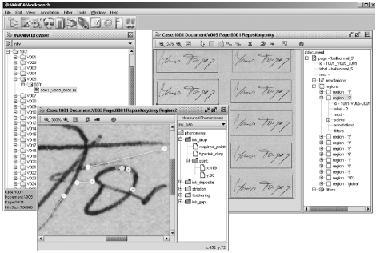 |
Interesting Articles about Popular Topics |
|
|
Dave Carlson - September 1, 2006 Questioned Document Examination (QDE), has existed since at least 1870 (O'Connor, 2006, ¶ 1). Examples of cases requiring QDE are investigations involving “forgery, counterfeiting, mail fraud, kidnapping, con games, embezzlement, gambling, organized crime, white collar crime, art crime, theft, robbery, arson, burglary, homicide, serial murder, psychological profiling, and deviant sex crime” (O'Connor, 2006, ¶ 1). A significant discipline in the field of questioned document examination is signature validation. Frequently, the forensic examiner must discern if a signature provided as evidence is genuine or forged. To assist with the study of the science and art of signature comparison, Franke and Schomaker (2004) conducted an experiment to “prove the hypothesis that similar writing movements lead to similar ink traces and stroke phenomena” (p. 120). They used a computer numerical control (CNC) machine to reproduce the 3-dimensional kinematics (motion of a body without considering external forces (www.answers.com/kinematics)) and kinetics (“effects of forces on the motion of a body” (www.answers.com/kinetics)) of writing (p. 121). Creating an ink trace with a pen on paper that forms a signature involves many forces, including: horizontal movement of a pen in every conceivable direction when the writer forms the traces of the signature, vertical movement when the writer lifts the pen from the paper and presses the pen into the paper, fluctuating velocity of the pen tip at different positions within the trace, variance of the writer’s joint reaction and muscle force of the writer affecting the dampening of pen movements, friction between the writing tip and the paper, steadiness of the pen tip (known as tip switch stroke), as well as a myriad of subtle differences in ink composition and characteristics (Franke & Schomaker, 2004). The experiment endeavored to capture and recreate consistent results derived from the aforementioned forces. The first electro-mechanical device to produce robotically synthesized handwriting was introduced in 1961. Even though were at least two later attempts, including anthropomorphic robots that successfully duplicated natural pen-point kinematics, none of these devices were able to effectuate a variable pen force (Franke & Schomaker, 2004, p. 121). Other than research applications, these devices for producing ink traces are used predominately by pen manufacturers to validate the quality of their writing instruments (Franke & Schomaker, 2004, p. 121). Franke and Schomaker (2004) observed that, because “the variation of pen tip forces was missing” (p. 122), ink traces produced by these machines were insufficient for forensic study. The experiment utilized a CNC machine, developed to manufacture highly complex three-dimensional components that require a high degree of precision, as a writing robot. Human writers provided precise input for programming the CNC machine implementing a digitizing pen tablet. With this configuration, Franke and Schomaker (2004) were able to “(a) study the ink depositing process form different writing utensils and (b) elucidate the differences in pen pressure variation between an ideal and passive mechanical writing system and the human writer, as a function of pen-lift” (p 124). The crux of the experiment was to determine the accuracy of specific synthesized robot movements and evaluate the stability of “produced stroke morphology characteristics, in particular link quality and ink deposit phenomena” (Franke & Schomaker, 2004, p. 124). The experimenters employed standard forensic equipment and techniques, such as stereomicroscope, variable lighting, and handwriting analysis software (see Figure 1), to examine the samples, paying close attention to “striations beginning and ending, feathering beginning and ending, ink drop, ink gaps, and ink deposits” (Franke & Schomaker, 2004, p. 125).  (Franke & Schomaker, 2004, p. 125) The experiment’s outcome was conclusive. “The reproducibility of the artificial writing traces with respect to pen displacement is extremely high” (Franke & Schomaker, 2004, p. 126). The CNC machine proved to be an accurate and reliable device to consistently produce writing traces with 24 different ballpoint pens using ten unique handwriting samples. Even considering variations caused by fluidity and differing smeary nature of ink samples, “the reproducibility and stability of stroke phenomena is unquestionable” (Franke & Schomaker, 2004, p. 127). They proved that “similar writing movements lead to similar ink deposits and ink trace phenomena if the same kind of pen is employed for writing” (Franke & Schomaker, 2004, p. 129). The experiment can be characterized as an unequivocal success. Franke and Schomaker (2004) demonstrated conclusively the feasibility of an electro-mechanical device, such as a CNC flatbed machine, to “reproduce exactly the same writing movement” (p. 130) created by “pen, ink, paper and writing surface support” (p. 130). Their conclusion about robotic writers is that “it is worthwhile to further develop the technology and to employ them in fundamental research and practical casework” (p. 130). Franke, K. and Schomaker, L. (2004). Robotic writing trace synthesis and its application in the study of signature line quality. [Electronic version]. Journal of Forensic Document Examination, 16(3), 119–146. O'Connor, T. (2006). Questioned document examination. Retrieved September 1, 2006, from http://faculty.ncwc.edu/toconnor/425/425lect05.htm |
||||
|